Effects of pyrroloquinoline quinone on noise-induced and age-related hearing loss in mice
- PMID: 36151123
- PMCID: PMC9508078
- DOI: 10.1038/s41598-022-19842-w
Effects of pyrroloquinoline quinone on noise-induced and age-related hearing loss in mice
Abstract
We investigated whether the oxidoreductase cofactor pyrroloquinoline quinone (PQQ) prevents noise-induced and age-related hearing loss (NIHL and ARHL) in mice. To assess NIHL, 8 week-old mice with and without PQQ administration were exposed to noise for 4 h. PQQ was orally administered for one week before and after noise exposure and subcutaneously once before noise exposure. For ARHL evaluation, mice were given drinking water with or without PQQ starting at 2 months of age. In the NIHL model, PQQ-treated mice had auditory brainstem response (ABR) thresholds of significantly reduced elevation at 8 kHz, a significantly increased number of hair cells at the basal turn, and significantly better maintained synapses beneath the inner hair cells compared to controls. In the ARHL model, PQQ significantly attenuated the age-related increase in ABR thresholds at 8 and 32 kHz at 10 months of age compared to controls. In addition, the hair cells, spiral ganglion cells, ribbon synapses, stria vascularis and nerve fibers were all significantly better maintained in PQQ-treated animals compared to controls at 10 months of age. These physiological and histological results demonstrate that PQQ protects the auditory system from NIHL and ARHL in mice.
© 2022. The Author(s).
Conflict of interest statement
This work was financially supported by ROHTO Pharmaceutical Co., Ltd. (Osaka, Japan).
Figures
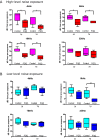

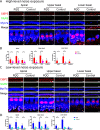
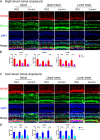

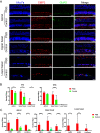
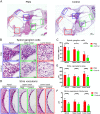
Similar articles
-
Noise induced reversible changes of cochlear ribbon synapses contribute to temporary hearing loss in mice.Acta Otolaryngol. 2015;135(11):1093-102. doi: 10.3109/00016489.2015.1061699. Epub 2015 Jul 3. Acta Otolaryngol. 2015. PMID: 26139555
-
Primary Neural Degeneration in Noise-Exposed Human Cochleas: Correlations with Outer Hair Cell Loss and Word-Discrimination Scores.J Neurosci. 2021 May 19;41(20):4439-4447. doi: 10.1523/JNEUROSCI.3238-20.2021. Epub 2021 Apr 21. J Neurosci. 2021. PMID: 33883202 Free PMC article.
-
Noise overstimulation of young adult UMHET4 mice accelerates age-related hearing loss.Hear Res. 2022 Oct;424:108601. doi: 10.1016/j.heares.2022.108601. Epub 2022 Sep 5. Hear Res. 2022. PMID: 36126618
-
Genetic influences on susceptibility of the auditory system to aging and environmental factors.Scand Audiol Suppl. 1992;36:1-39. Scand Audiol Suppl. 1992. PMID: 1488615 Review.
-
Presbyacusis and the auditory brainstem response.J Speech Lang Hear Res. 2002 Dec;45(6):1249-61. doi: 10.1044/1092-4388(2002/100). J Speech Lang Hear Res. 2002. PMID: 12546491 Review.
Cited by
-
Dietary pyrroloquinoline quinone hinders aging progression in male mice and D-galactose-induced cells.Front Aging. 2024 Feb 29;5:1351860. doi: 10.3389/fragi.2024.1351860. eCollection 2024. Front Aging. 2024. PMID: 38487591 Free PMC article.
References
-
- Ries PW. Prevalence and characteristics of persons with hearing trouble: United States 1990-91. Vital Health Stat. 10. 1994;188(188):1–75. - PubMed
Publication types
MeSH terms
Substances
LinkOut - more resources
Full Text Sources

